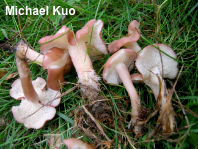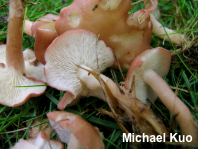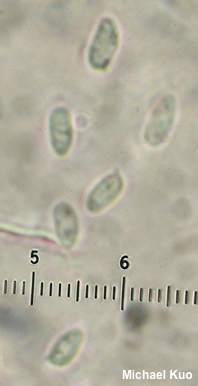| Major Groups > Gilled Mushrooms > Pale-Spored > Collybioid > Calocybe carnea |

|
[ Basidiomycota > Agaricales > Lyophyllaceae > Calocybe . . . ] Calocybe carnea by Michael Kuo, 2 November 2022 Widespread but apparently not common in North America, Calocybe carnea is a small pink mushroom that grows in lawns and meadows. It has a white spore print, and white gills that are attached to the stem. Under the microscope, it has small, inamyloid spores and lacks cystidia. I have seen it only once, in 30 years of mushroom collecting; the collection described and illustrated here was made on a lawn in northern Michigan in 2007. Calocybe persicolor is a synonym, if you ask me (you don't have to, of course). Its putative differences rather depend on what author you consult; Kalamees (2018) emphasizes darker pink colors, a hairy stem base, and a tendency to grow in clusters in forests for Calocybe persicina, while Calocybe carnea is paler, has a naked stem base, and grows in grasslands, not forming clusters. However, some of these differences are at odds with the original and early illustrations and descriptions of the species. Fries (1821), for example, calls the stem of Calocybe carnea "villoso-squamulosus" (hairy-scaly) and says the species appears "[i]n pinetis locisque graminosis" (in pine woods and in grassy places). Some contemporary authors (e.g. Læssøe & Petersen 2019, Breitenbach & Kränzlin 1991) express doubt about the legitimacy of separating the species—and DNA results from ITS sequences in one study (Bellanger et al. 2015), while based on only one gene, are suggestive of the possibility that the two "species" are the same. Description: Ecology: Saprobic; growing alone, scattered, gregariously, or in small clusters in grassy areas; usually found in cultivated or disturbed-ground areas, but occasionally found in woods; summer and fall; originally described from France (Bulliard 1792); widespread in Europe and in North America, north of Mexico; also reported from Oceania. The illustrated and described collection is from Michigan. Cap: 2–4 cm across; convex, becoming broadly convex, flat, or shallowly depressed; the margin inrolled at first, but becoming wavy with age, or sometimes splitting into lobes; dry; bald; rose pink. Gills: Attached to the stem, sometimes by means of a notch; close or crowded; short-gills frequent; white. Stem: 2–5 cm long; 0.5–1 cm thick; becoming hollow with age; bald or with white hairs and fuzz, especially basally; colored like the cap. Flesh: Whitish; not changing when sliced. Odor & Taste: Not distinctive, or sometimes faintly mealy. Chemical Reactions: KOH on cap surface negative.Spore Print: White. Microscopic Features: Spores 3–5 x 1.5–2.5 µm; subellipsoid, subcylindric, or irregularly elongated-amygdaliform; smooth; hyaline in KOH; inamyloid. Basidia 18–22 x 4–5 µm; 4-sterigmate. Hymenial cystidia not found. Lamellar trama parallel. Pileipellis a thin, partially gelatinized cutis; elements 2–7.5 µm wide, smooth, hyaline in KOH. Clamp connections present. REFERENCES: (J. B. F. Bulliard, 1792) M. A. Donk, 1962. (Fries, 1821; Fries, 1874; Kauffman, 1918; Singer, 1978; Phillips, 1981; Moser, 1983; Arora, 1986; Breitenbach & Kränzlin, 1991; Phillips, 1991/2005; Schalkwijk-Barendsen, 1991; Lincoff, 1992; Barron, 1999; Roody, 2003; McNeil, 2006; Buczacki et al., 2013; Hofstetter et al., 2014; Bellanger et al., 2015; Gminder & Böhning, 2017; Wood & Dunkelman, 2017; Kalamees, 2018; Læssøe & Petersen, 2019; Kibby, 2020; Qi et al., 2022.) Herb. Kuo 09120703. This site contains no information about the edibility or toxicity of mushrooms. |
© MushroomExpert.Com |
|
Cite this page as: Kuo, M. (2022, November). Calocybe carnea. Retrieved from the MushroomExpert.Com Web site: http://www.mushroomexpert.com/calocybe_carnea.html |


